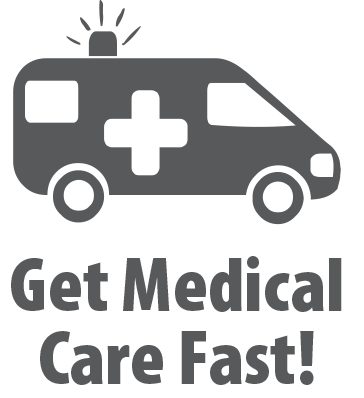Bone & Muscle Problems
Sickle Cell Anemia
Red blood cells are normally round. In sickle cell anemia, the red blood cells take on a sickle shape. This makes the blood thicker and doesn’t let oxygen get to the body’s tissues like it should. When sickled cells get stuck in the blood vessels, they cut off the blood supply. With no oxygen, pain occurs. The result is a “Sickle Cell Crisis.”
Signs & Symptoms
• Bone and joint pain. This is the most common complaint. The pain can also be in the chest, back, or abdomen.
• Shortness of breath and a hard time breathing.
• Swollen hands and feet.
• Jaundice. The whites of the eyes and/or the skin looks yellow.
• Paleness.
• Repeated infections, especially pneumonia or meningitis.
• Kidney problems. Leg ulcers. Gallstones (at an early age). Gout.
• Seizures.
• Strokes (at an early age).
Causes
Sickle cell anemia is inherited. In the U.S., it mostly affects African Americans, but can occur in other ethnic groups. Examples are persons whose ancestors are from Cuba, Central and South America, Greece, Italy, Turkey, and Saudi Arabia. About 1 in 12 African Americans carries the gene for the sickle cell trait. If both parents carry the trait, the chance of having a child with sickle cell anemia is 1 out of 4. About 1 in 375 African Americans and about 1 in every 1,000 Latin Americans are born with sickle cell anemia. Signs of the disease aren’t noticed until the end of the infant’s first year. All hospitals in the U.S. screen newborns for sickle cell disease.
To prevent sickle cell anemia in offspring, couples, especially African American couples, should have a blood test to see if they are carriers for the sickle cell trait. Genetic counseling can help them decide what to do.
Treatment
Medical treatment is needed. Painful episodes are treated with painkillers, fluids, and oxygen. Other treatments:
• Hydroxyurea medicine.
• Blood transfusions.
• Stem cell transplant. This may be an option for children who have a brother or sister without sickle cell disease that is a matched donor.
In the U.S., the life span for a person with sickle cell disease is 40-60 years.
Questions to Ask
Question
01
Are any signs and symptoms of a stroke present?

Get medical care without delay. If symptoms are life threatening go to the ER or call 9-1-1. Don’t call 9-1-1 or use the ER if symptoms do not threaten life. Ask your doctor ahead of time where you should go for a problem that needs prompt care, but not emergency care.
x
Question
02
Do any of these problems occur?
• Severe shortness of breath or chest pain with rapid breathing.
• Severe abdominal pain.
• Constant vomiting.
• Chest pain with or without a cough.
• Fainting. Seizure.
• Severe pain in a bone or joint.

Get medical care without delay. If symptoms are life threatening go to the ER or call 9-1-1. Don’t call 9-1-1 or use the ER if symptoms do not threaten life. Ask your doctor ahead of time where you should go for a problem that needs prompt care, but not emergency care.
x
Question
03
With sickle cell anemia are any of these problems present?
• Swelling of the feet and hand sand shortness of breath.
• Increased yellow color to the skin or the whites of the eyes.
• Redness, swelling, pus, fever, or a sore that does not heal.
• Bloody or cloudy urine. Increased paleness. A new onset of weakness. Leg sores. Mild symptoms after exposure to high altitudes or cold temperatures.

You should be seen by your doctor for medical advice. Contact your doctor or health care provider to find out how soon you should be seen.
x
Question
04
Does an infant have any of these signs?
• Nosebleeds.
• Frequent respiratory infections.
• Paleness. Fatigue. Acting very cranky.
• Yellow color to the skin or the whites of the eyes.
• Feeding poorly.

You should be seen by your doctor for medical advice. Contact your doctor or health care provider to find out how soon you should be seen.
x
Question
05
Does an adolescent or young adult with sickle cell anemia have severe joint pain, anemia that worsens, leg sores, or gum disease?

You should be seen by your doctor for medical advice. Contact your doctor or health care provider to find out how soon you should be seen.
x
Self-Care / Prevention
• Follow your doctor’s treatment plan. Wear a medical alert tag.
• Avoid physical stress and high altitudes.
• Discuss airplane travel with your doctor.
• Ask your doctor what over-the- counter medicines you can use before you try any.
• Drink at least 8 glasses of water a day. Get the rest you need.
• Follow a balanced diet. Have at least 5 servings of fruits and vegetables a day. Take folic acid (a B vitamin) supplements and other vitamins and minerals, as advised by your doctor.
• Don’t wear tight clothing.
• If at home and in a “sickle cell crisis:”
– Stay warm. Apply warm compresses to painful parts of your body.
– Rest in bed.
– Take pain medication, as prescribed.

Download an offline pdf file.
2021 © American Institute for Preventive Medicine - All Rights Reserved. Disclaimer | www.HealthyLife.com








